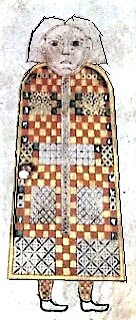There was an expectation in the early church that priests wear garments that were decent, white and clean;[1] it was seen as appropriate for handling the sacraments in a mass. Mention in the 2nd-century was made of a thin, sleeved, upper tunic worn by deacons in the church in Rome.[2] The tunic was originally made of wool, but this would have irritated the skin so by the 3rd-century it was a linen vestment. From the 5th-century the church regulated that priests should be dressed distinctly. They had to wear a tunic, tunica alba or alb,[3] which extended down to the feet.[4] A stole shaped as a narrow band of silk worn around the neck and draped to the bottom of the alb became an extra. If it crossed over at the front it signified a priest and if it extended straight downwards it showed a bishop. A long-sleeved upper tunic, tunica dalmatica or dalmatic, began to appear in the 5th-century. Covering this was a round garment with a hole in the centre to pass the head through. This chasuble[5] extended down to the lower body and in time became highly decorated. It had developed from the casula, meaning a ‘little house,’ which was a similar garment worn by high status, ancient Romans. The earliest written mention of the chasuble as a liturgical vestment comes in a letter written by St Germain of Paris, late 6th-century. Shoes stayed much like the shoe of the Romans; a flat leather sole with laces or straps to wrap around the foot.
St Ambrose mosaic,
5th-century, in the chapel of San Vittore in the basilica of St Ambrose in
Milan. Note the chasuble is loose fitting and without sleeves to allow free
movement of the arms. Below it is a dalmatic with loose sleeves and below that
is the alb down to near the feet. Note also the simple leather shoes.
The three main layers, alb,
dalmatic and chasuble were being worn by most priests by the end of the
5th-century. Today in the Anglican church the alb has become the cassock-alb,
tied around the waist by a cord or belt called a cincture, and is the common
garment for any minister. The dalmatic is the outermost garment of deacons
and the chasuble is worn by priests and bishops. 
From the
left: 17th-century alb, dalmatic and a chasuble in Renaissance style.
Chad in the
7th-century might have worn an undergarment like an alb made of linen and have it
covered with a dalmatic-type garment, possibly made of wool. Chad was trained
in the Celtic (Ionian) theology of early Lindisfarne, Iona and Northern Ireland
monasteries and their dress is uncertain. Most images of ‘Celtic priests’ are
like modern Druids. It is known their tonsure was across the front of the head
and this appearance was shown in The Book of Durrow. The image shows a
decorated outer garment like an alb. Chad could have worn a pectoral cross, see
the post ‘Cross for a bishop of Mercia,’ and it is surprising this is rarely
shown in artwork. From early 7th-century the pope sent a gift of a pallium or
dalmatic to bishops to signify their office. The pallium was a narrow,
circular, woollen band with a short piece hanging down the front and another
down the back. It was decorated with six black crosses. It is not known if Chad
ever received one after his late consecration into the Roman church. His shoes
would have been simple.

 Book of
Mulling or Moling, late-8th or early 9th-century. John the Evangelist, folio
81v. Note the front tonsure is now gone. John wears an alb and a chasuble.
Shoes are no longer a plain sole with straps.
Book of
Mulling or Moling, late-8th or early 9th-century. John the Evangelist, folio
81v. Note the front tonsure is now gone. John wears an alb and a chasuble.
Shoes are no longer a plain sole with straps.
With Reformation and the Book of Common Prayer, 1549, came simplicity of vestments with a black gown and ruff being favoured. During Elizabeth’s reign the old clerical vestments were revived.
Bishop George Abbot, 1609–10, who became the Archbishop of
Canterbury. Wikimedia Commons. He is wearing a white alb under his black gown.
[1]
37th canon of Hyppolytus, 4th-century, and St Jerome in his commentary on
Ezekiel 44, 19, (414).
[2]
In the Liber Pontificalis the garment was described by Pope
Sylvester, 314–335.
[3]
Alb comes from album meaning white.
[5]
It originated from a Spanish poncho, that is, a large cape with a hole for the
head to go through, hanging in folds around the body.
[6]
The pointed shape of the mitre signifies the tongues of fire appearing on the
apostles at Pentecost. Acts 2, 1–3. The two parts that comprise the mitre are
said to represent the two natures of Christ, human and divine. The two hanging bands,
lappets, on the back are said to represent the New and Old Testament.
[7]
Never officially approved by the Church of England.
[8]
The 1345–6 Sacrist’s Roll listed many chasubles. The list included: ten
chasubles, six of red samite (heavy silk) said to be fairly-good with two
richly embroidered. One of dark blue samite and the other of green samite. One was
decorated with escallops and the other with flowers. Also, six chasubles
tolerably good. Also, one chasuble of cloth which good King Edward IV had
given, Also, six ordinary chasubles. Also, one chasuble of baldekin (rich silk),
with the alb, amice and stole embroidered with diverse shields. Also, one
chasuble of samite, with tunicles and dalmatics of light-blue sindon (thin
linen muslin). Also, one chasuble with two tunicles of dark blue samite.




